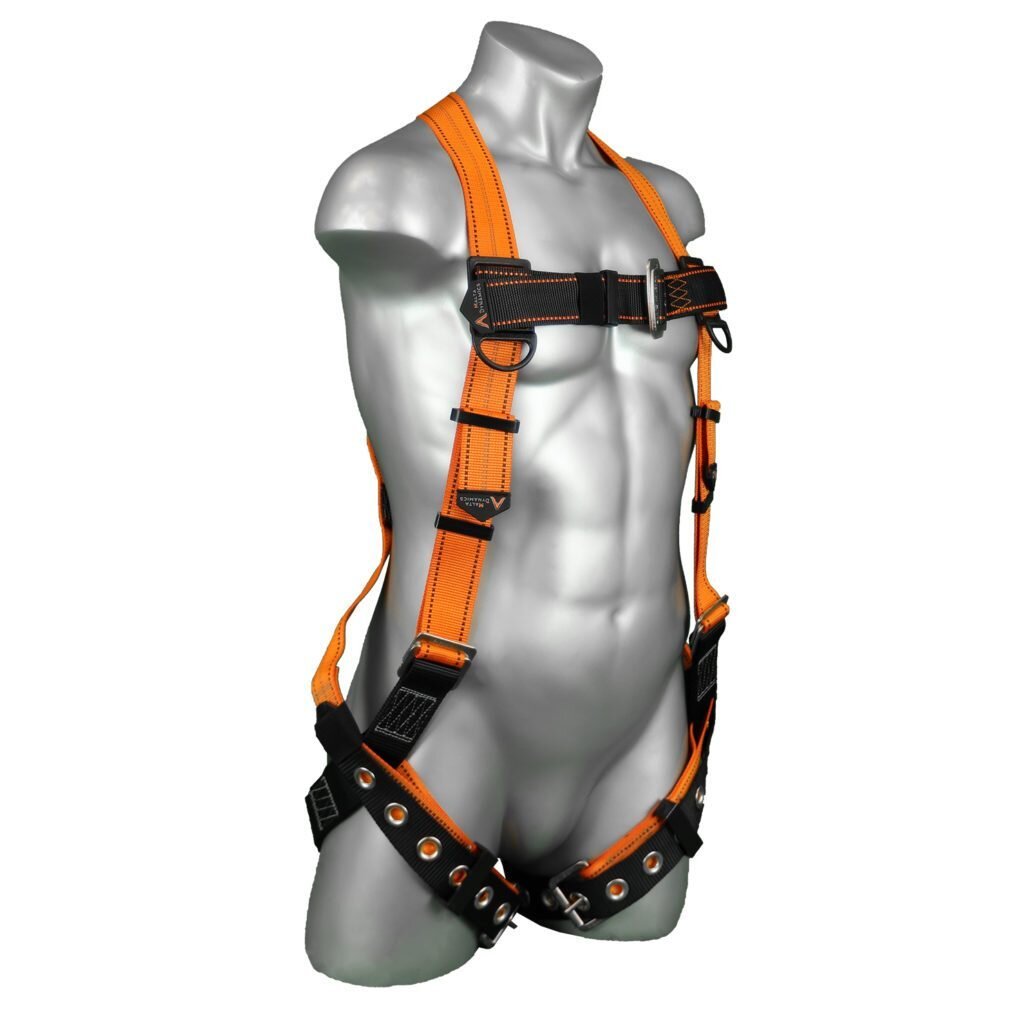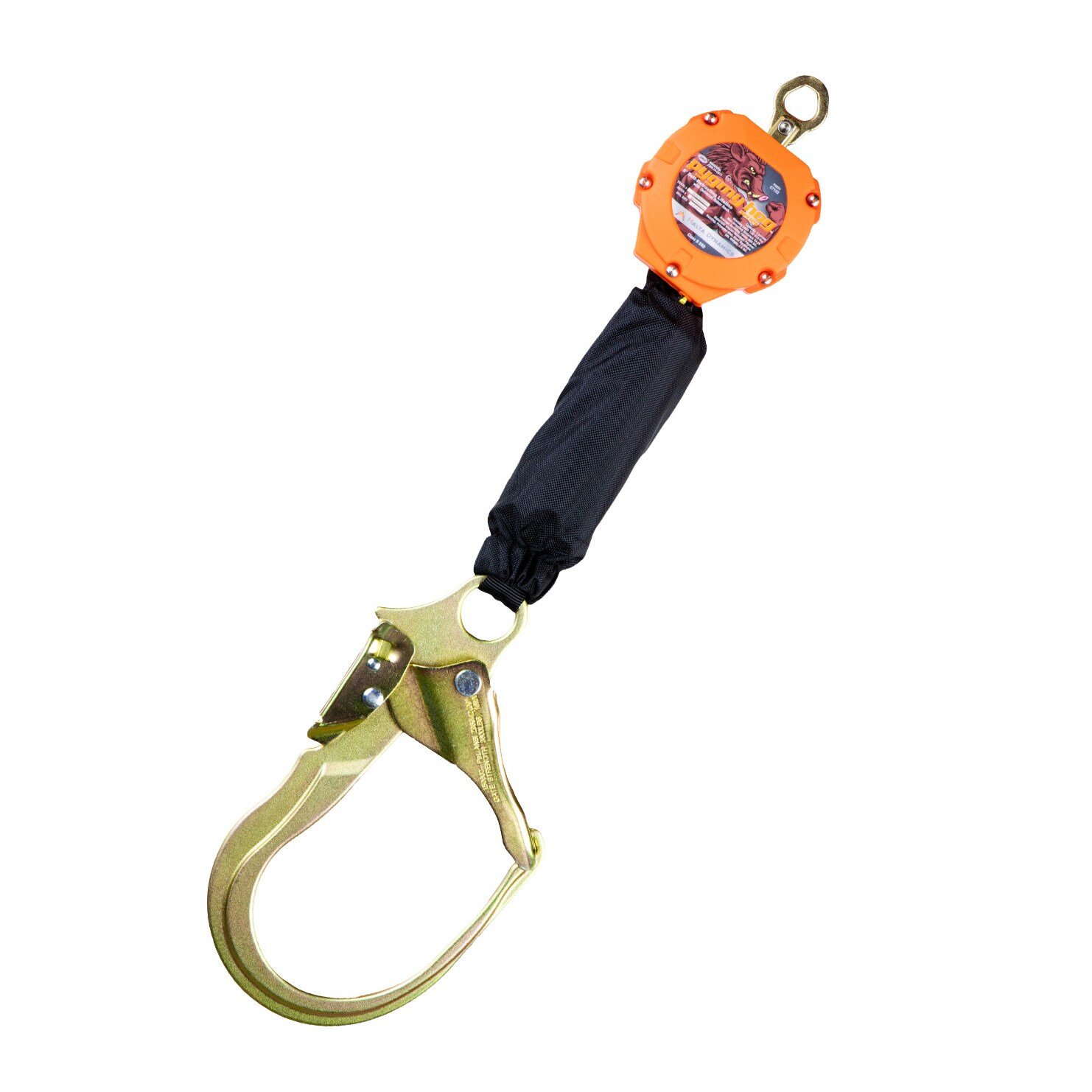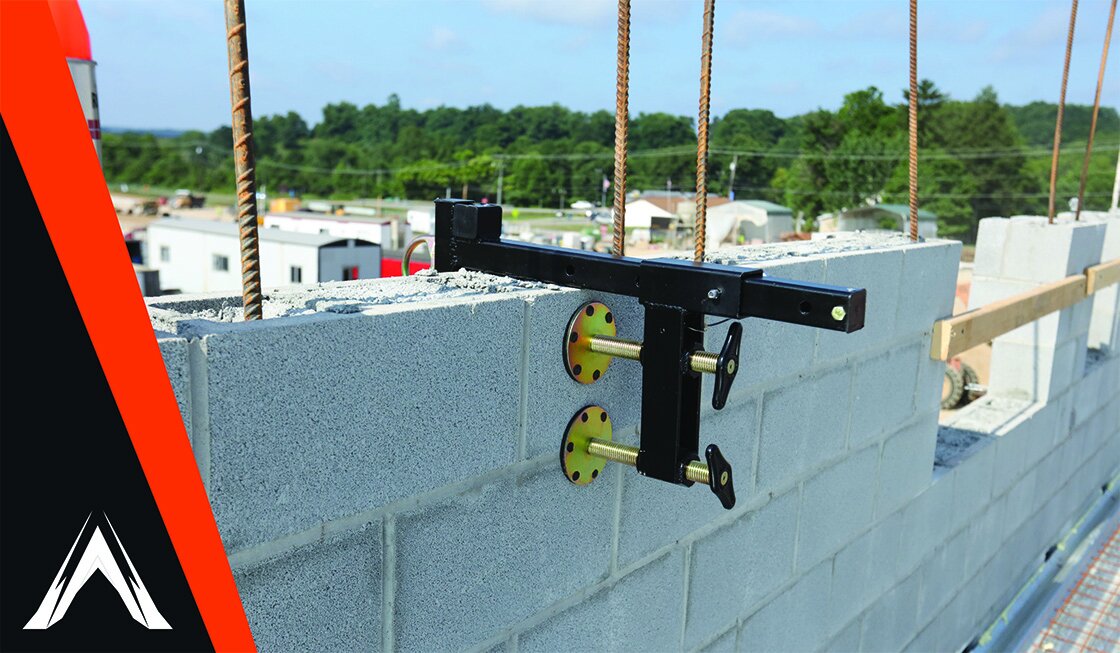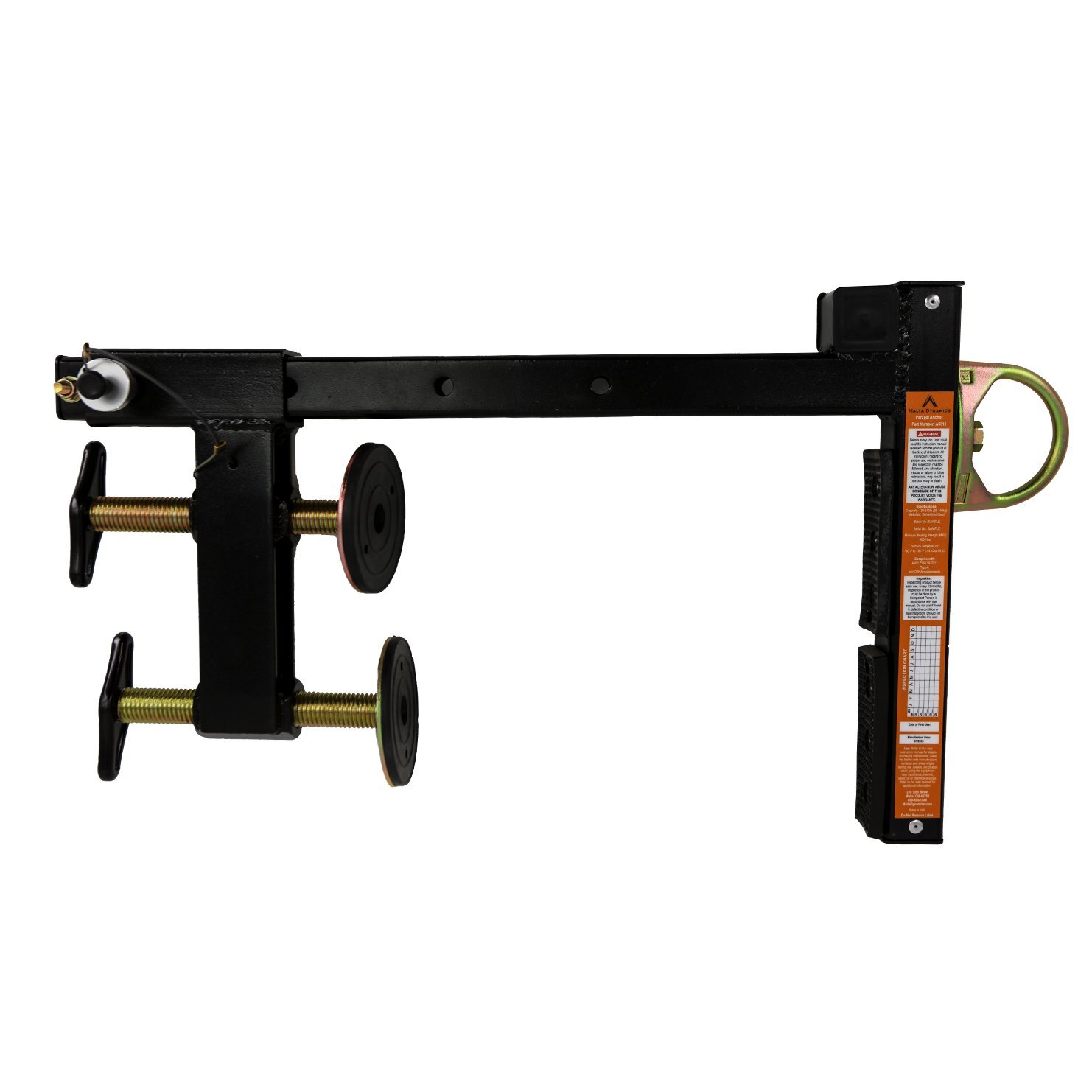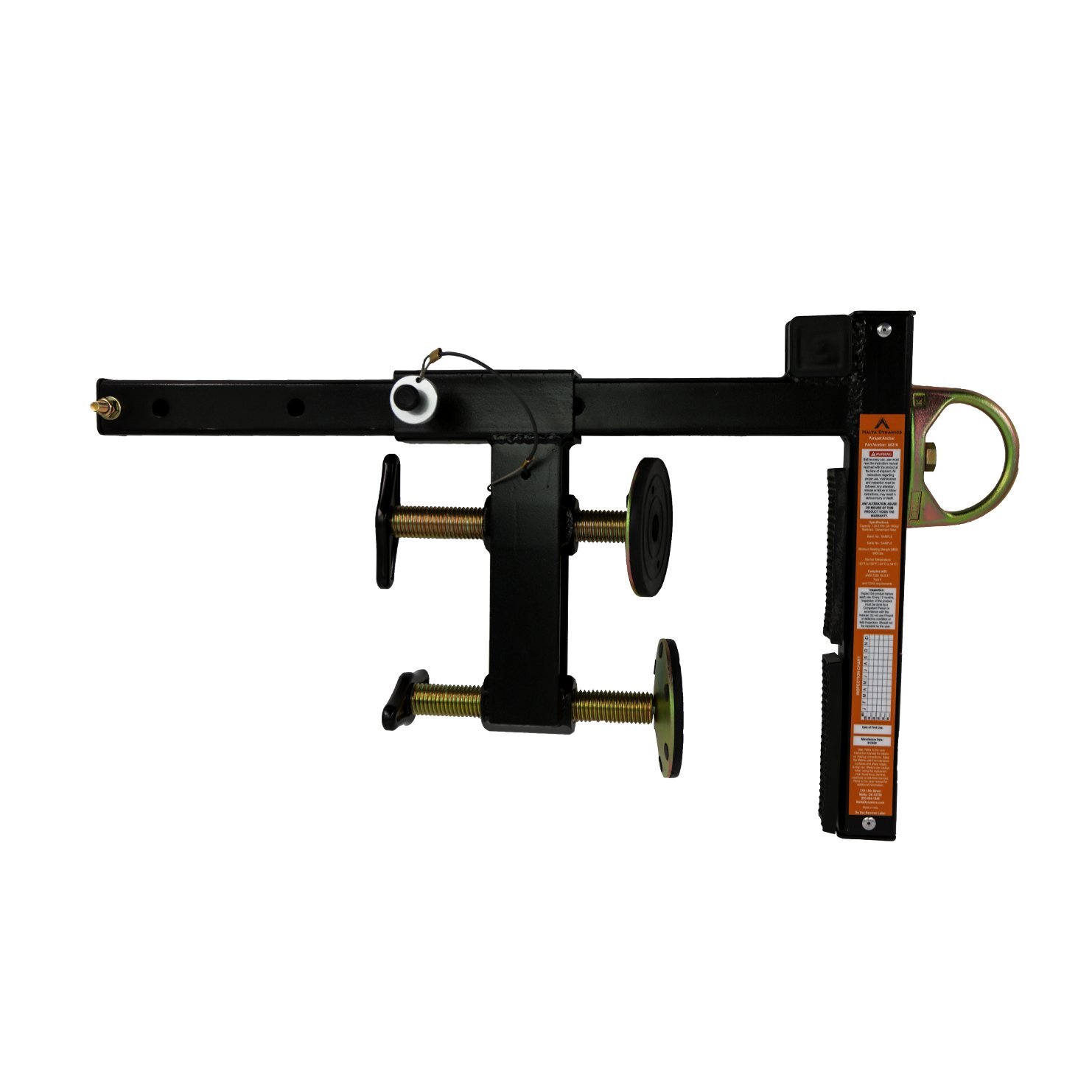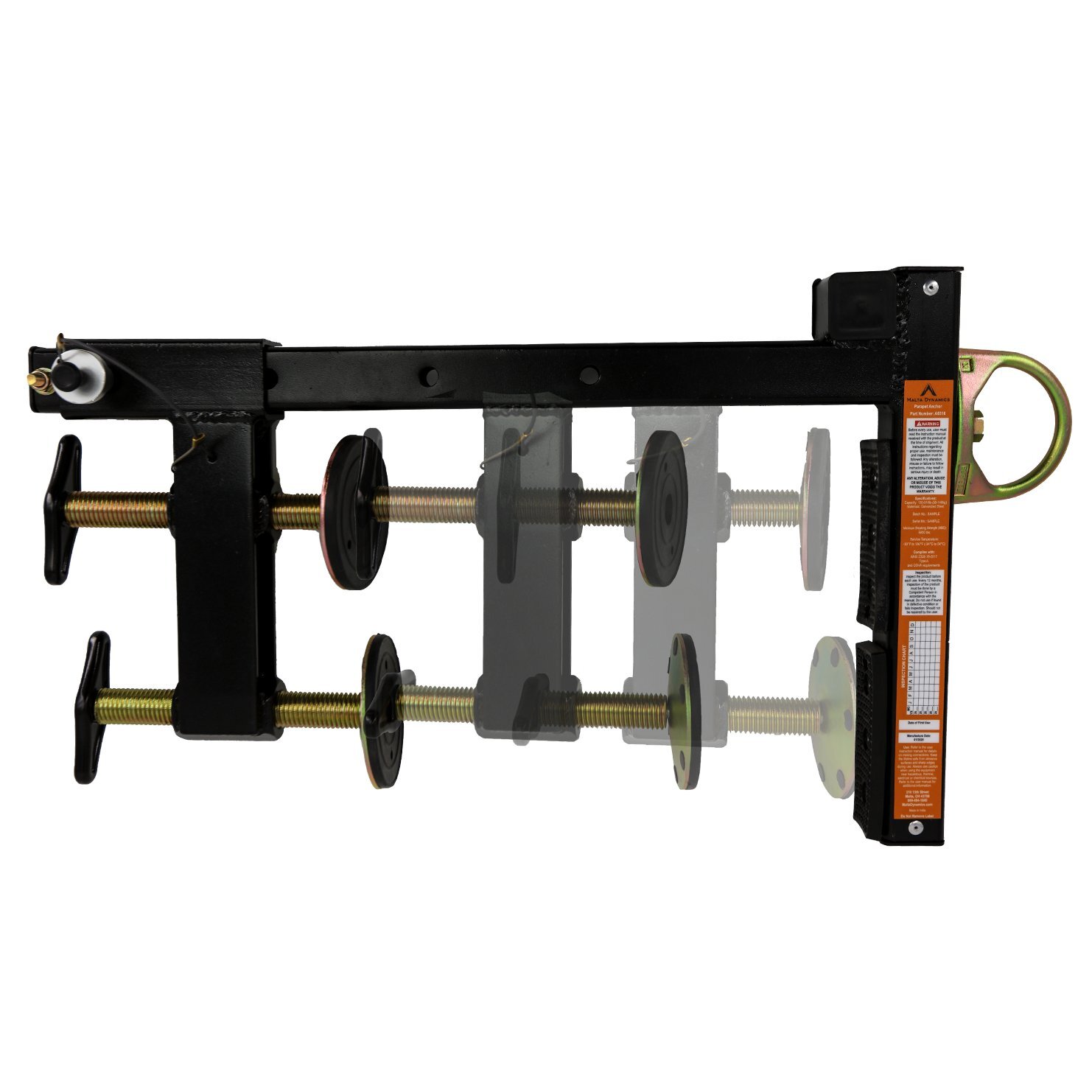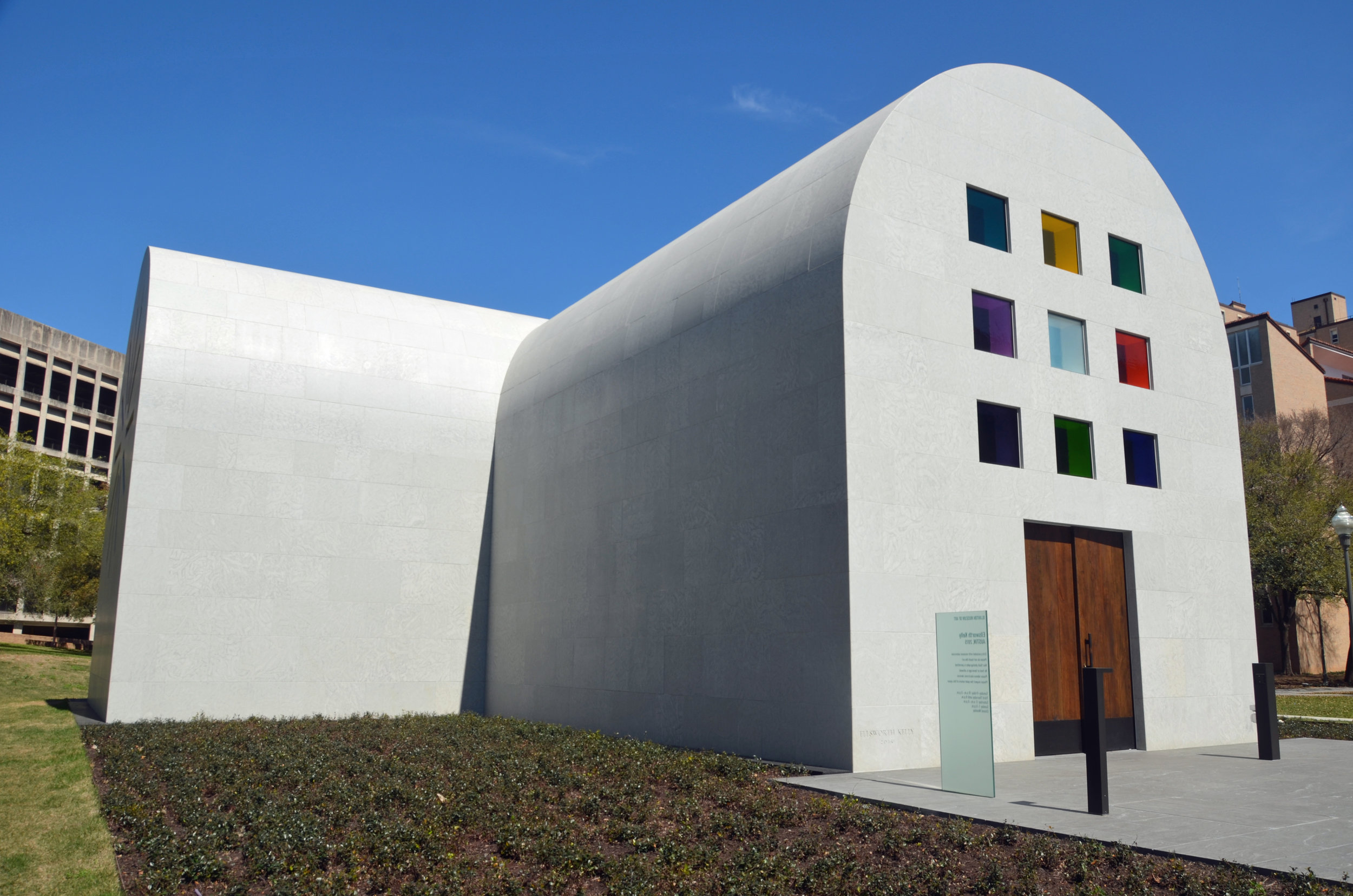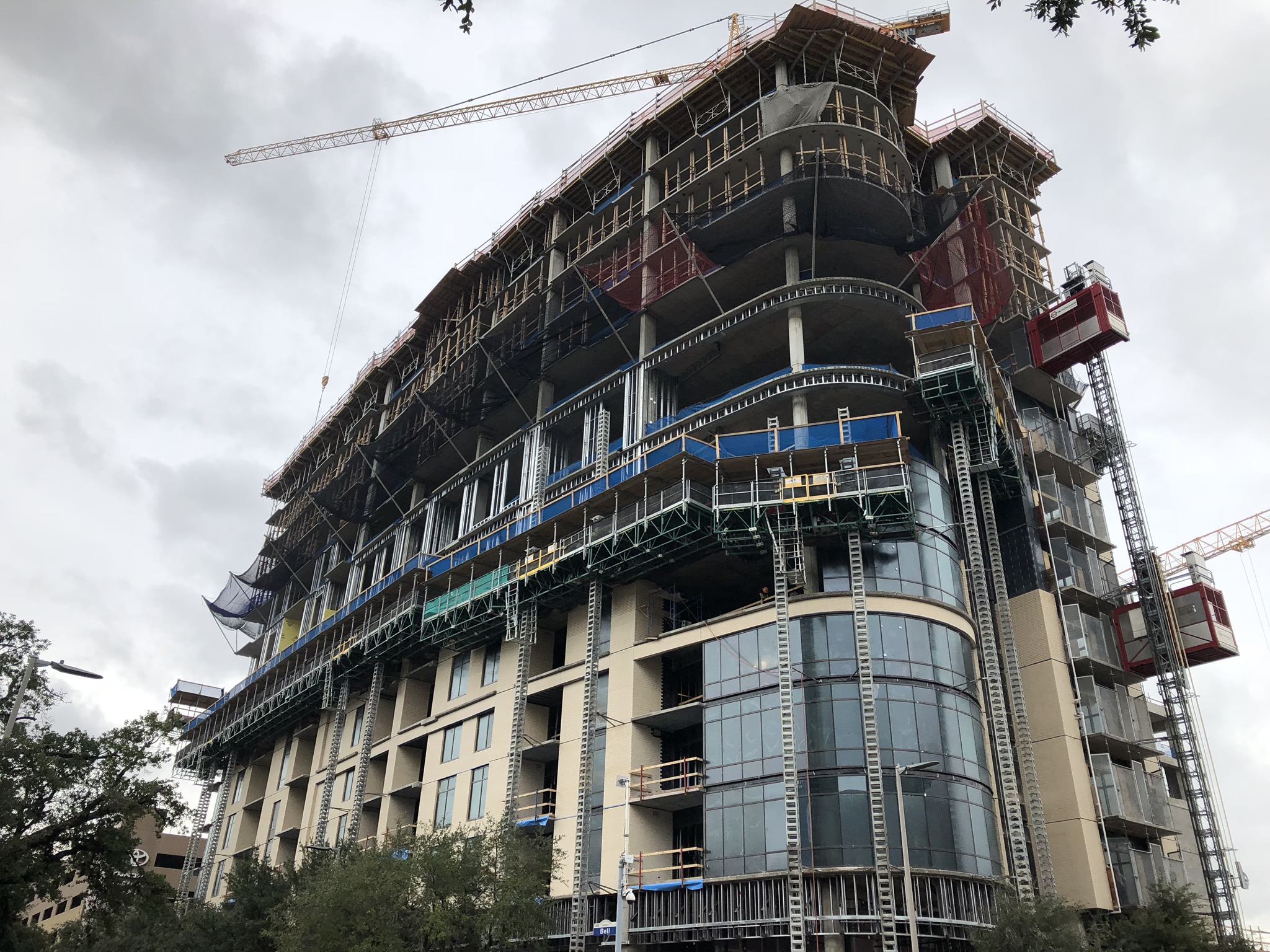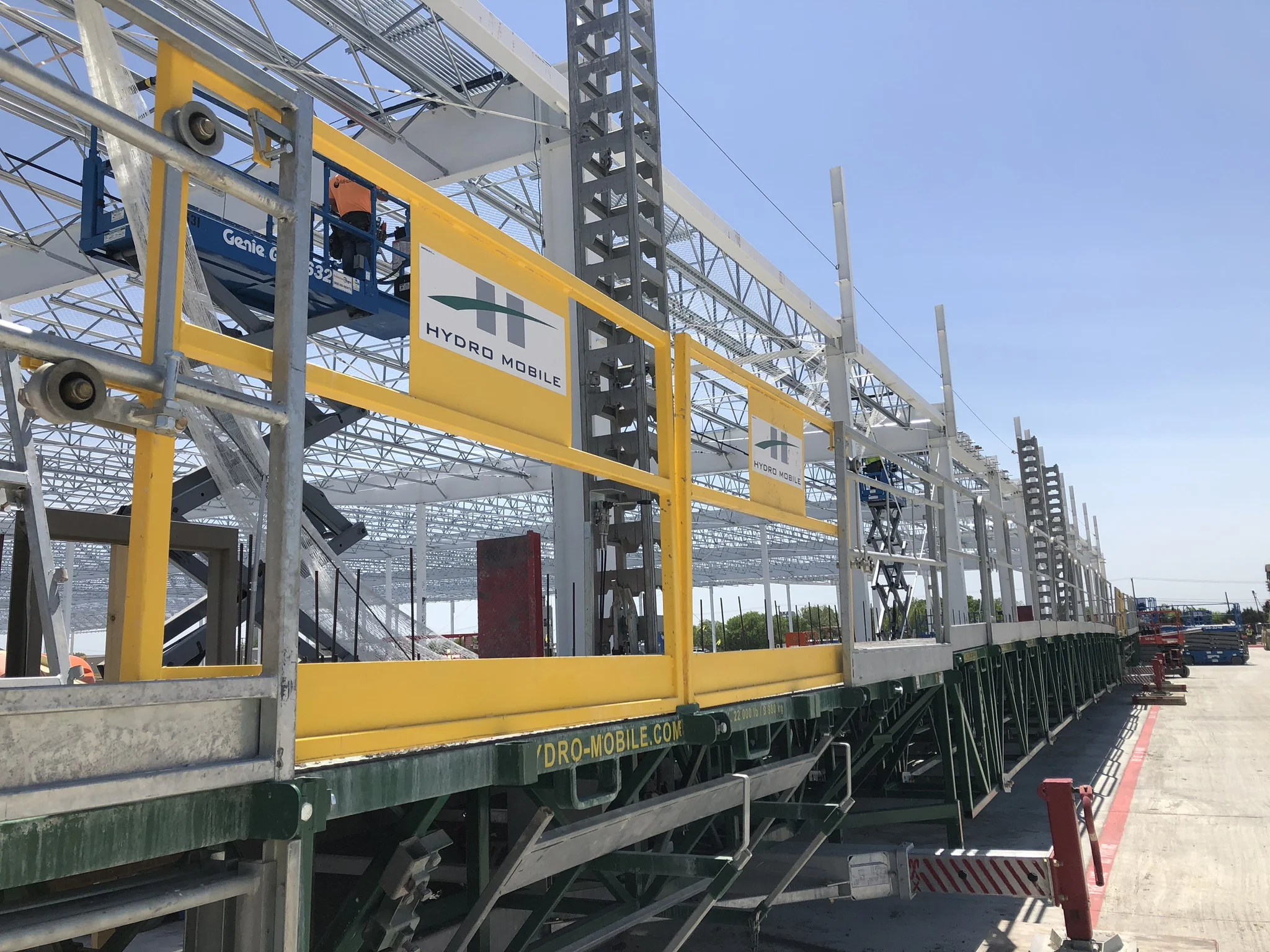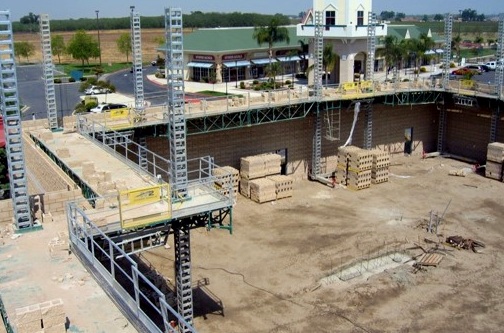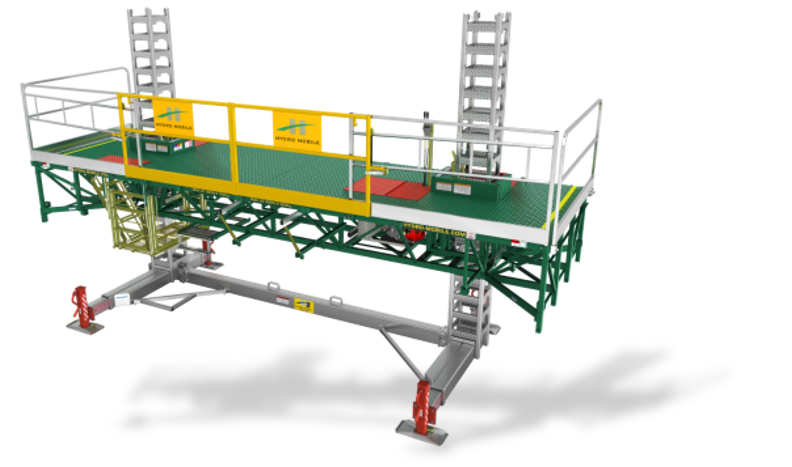Looking for a safe and productive solution for your next construction project? Check out our Mast Climber Monday blog post, featuring a project we worked on with Trinity Masonry a few years ago. Using Hydro Mobile M2 Mast Climbers with a M2 Hoist, our team helped keep the First National Bank project in Killeen, Texas running smoothly and efficiently. With a hoist capacity of 4,000 pounds and spacious 7' front-to-back mast climber decks, these reliable and efficient machines provided a safe and productive work environment. Don't miss the photos from the construction process! Contact us at Spec Rents to learn how we can help you increase productivity and safety on your next project, no matter the size or complexity.
Read moreBoost Your Construction Project's Efficiency with the Hydro Mobile M2 Hoist
Maximize your construction project's efficiency with the Hydro Mobile M2 hoist. Capable of hoisting up to 4,000 lbs, the M2 hoist can help you overcome common challenges like limited access, inefficient loading, and waiting on crane time. Learn how the M2 hoist can help you stay on schedule and avoid costly delays.
Read moreBricks Bags and Blocks for Bikes- Malta Dynamic Fall Protection Bundle Available in Online Auction
For the past couple of years, Spec Mix has hosted an auction in conjunction with the SPEC MIX BRICKLAYER 500 competition in North Texas. This year, the goal is to raise $50,000 to purchase bikes for the underprivileged children of the Dallas, Ft. Worth area. In the spirit of the holiday season the Masonry Trade and its supporters wish to take this opportunity to give back to our community in partnership with our local ABC Channel 8 – WFAA. This year we hope you’ll join us in making a difference in the life of a deserving child.
This year the auction going online to allow more exposure and Spec Rents is happy to play a small part in it by donating a Malta Dynamics Fall Protection bundle (see below pictures and description) for the auction. You can see details below and be sure to go to Spec Mix’s Bricks, Blocks & Bags for Bikes page to bid on this item and the other great products up for auction. Final results will be announced at the SPEC MIX JR BRICKLAYER 500 event.
Malta Dynamics Fall Protection Bundle - $350 value
Don’t wait! Check out Bricks, Blocks & Bags for Bikes today at: https://www.specmix.com/bbb-for-bikes/
New Way to Anchor for Fall Protection: Reusable Parapet Anchor
Yesterday I was on the MCAA (Mason Contractors Association of America) Safety Round Table virtual meeting and the topic that the group voted to talk about was Fall Protection. Of all of the challenges that we discussed, probably the most common was finding safe and adequate places to tie off to, when necessary.
Some scaffold systems, such as Hydro Mobile, have engineered anchor points on the scaffold that you can easily tie to. Sometimes you will be on a building that has an engineered anchor point overhead that’s convenient. However, we discussed that finding an adequate anchorage point is sometimes a challenge.
It was coincidence that a couple hours after our round table was over that I received an update from Malta Dynamics, which we proudly provide to our customers. They’ve created a new temporary anchor: the reusable parapet anchor. Although, this anchor might not work in all scenarios, it is one more thing to help you as a contractor when you’re faced with the challenge of where to tie off to safely.
Malta Dynamics Reusable Parapet Anchor
Learn more about this new anchor solution that doesn’t damage roof walls, designed specifically for flat roofs surrounded by parapet walls here.
Spec Rents a the proud distributor of Hydro Mobile Mast Climbers, Malta Dynamics safety and fall protection equipment, EZG Manufacturing, Norton Clipper saws, and Husqvarna saws and equipment for Texas. Although we are technically an equipment company, we’re not just in business to sell and rent equipment. We provide our customers with equipment solutions that provide safety and increased productivity. Let us know if we can help you achieve your company’s goals.
Post by: Elizabeth "Liz" Graves, Sales Manager at Spec Rents, LLC. Contact Liz at lizg@specrents.com
Project Highlight: Frisco Station
Frisco Station is a 7 floor hotel project located in Frisco, Texas. The contractor, Design Construction, has years of experience in hotel projects and made the wise decision to use Hydro Mobile Mast Climbers to increase their productivity on this difficult stack-bond brick project.
This project is a challenge with the multiple returns, in addition to it being stack-bond pattern, requiring quality workmanship from the masons. The Hydro Mobile M2 Mast Climbers are versatile enough to provide the mason with a quick setup around corners and keep the flow going all the way up.
The above area shows a return that they were able to easily setup to cover the stairwell. The smaller length of the stairwell wall required the use of a 14’ M2 Hydro Mobile Mast Climber vs. the traditional 24’ M2 units used on other areas of the job. The 14’ M2 unit is able to provide the same large capacity of 22,000 lbs, a 7’ deep work platform, and stability of having two masts vs. using a single mast system.
Additionally, Design Construction used the M2 Hoist for this project to keep the masons continually stocked. At a capacity of 4,000 lbs and speed of 65 ft per minute, these hoists will keep production going, even after you’ve outreached your forklift.
Being their first project with mast climbers, Spec Rents held a full installation and dismantle training course for their E&D crew. Our instructors spent multiple days assisting in their first setups and going back out to assist with dismantling and moving units to additional setups.
If you’ve got a construction project coming up that you’re considering mast climbers on but haven’t taken the leap and have questions, give us a call. We’re happy to walk you through the process to find the best solution for your specific challenges.
Spec Rents is the proud distributor of Hydro Mobile for Texas. Although we are technically an equipment company, we’re not just in business to sell and rent equipment. We provide our customers with equipment solutions that provide safety and increased productivity. Let us know if we can help you achieve your company’s goals.
Post by: Elizabeth "Liz" Graves, Sales Manager at Spec Rents, LLC. Contact Liz at lizg@specrents.com
Bring back the Pride: 12 Ways to Bring Pride Back into Masonry
I hear it every day. “We can’t find good masons.” Or “There’s not enough labor out there.” The problem is two-fold, in my opinion.
We can’t find people who want to work in masonry.
We aren’t training enough people to fill the gap of those who are starting to retire.
I’m the proud daughter of a masonry contractor. My dad called himself an “artistic manipulator of the burnt clay product.” He started as a laborer for a company, went through an apprenticeship, was a mason, became a foreman, moved into estimating…. All with the same company. When that company started to slow down, he and my mom started their own company. He had pride in what he did. And I’m proud of the work he has done over the years and the work our company helps masons to do now.
I think this is something we are really missing out on. We need to bring back the pride.
What masons do is nothing less than an art. Think about being an electrician or a plumber or a framer. Sure, they’re also proud professions that are absolutely necessary. But what masons do is beautiful and lasting. It’s something you can be proud of for generations to come.
How can you help bring back the pride to masonry?
Here’s a 12 ideas to get you started.
Make a big deal out of the projects your crews are on. Tell them about it. They like to know details like how many brick are on it, what it will be, etc. Some companies have hats or shirts made for really big projects to give to their guys. Something small like that can go a long way. You’ll find the guys are proud to be a part of something like this.
Take part in masonry competitions throughout the country. These are a chance for the best masons to show just how great they are. These guys (and hopefully one day gals) are beasts- the amount of brick they can lay is nothing short of amazing. Encouraging and supporting your guys to train and then participate in these can be a great way to show that this is a great trade to be in. Check out the 2019 SPEC MIX BRICKLAYER 500® to learn more.
We build cool stuff but some of them may not ever get to see the finished project. Consider doing a company newsletter, whether paper or digitally. Or maybe do a Facebook page where you can share pictures and they can too. The younger generations live on this kind of stuff. Keeping your website up to date is important too.
Make new hires feel welcome by introducing them to the team they’re working with. Your crew should be a team. This means they know and help each other out. They watch out for the new guy and help them, showing them the ins and outs of both the company and project they’re starting on. You’ll find their productivity will go up substantially if you’ll do this. And, really, how hard would it be to introduce them at your weekly toolbox talk and pair them up with someone? This will give your current employees something to be proud of doing as well.
Train new hires appropriately on what expectations are, what benefits they have access to, and, most importantly, safety. It takes time to do this, but you’ll save a lot of headaches by doing so and they’ll know your company culture and be better acclimated to it this way. Spending time to do so shows you care about them as individuals. Happy employees = productive employees most of the time.
Have a company party yearly. This doesn’t have to be anything fancy but it’s a way for everyone to get together and see each other. Maybe do a slide show so their family can see the projects they’ve been on over the past year. Think of how proud your kids are when they show you all of the projects they’ve worked on for open house at school. It’s the same concept.
Advance from within your company when you can. Provide a career path that they can easily see. Some of the best superintendents, project managers, and estimators were labors and masons first. People want to be proud to grow up and advance within a company.
Recruit from high schools by creating relationships with counselors. We know that everyone isn’t going to college and doesn’t need to. Providing information on a career path in masonry and showing off the awesome projects they could work on, can help with recruiting. Check out the Top 10 Reasons to Join the Masonry Team booklet by MCAA. It’s available to MCAA members for free so be sure to order yourself some for your next recruiting efforts.
Communicate effectively- they want to know what’s in the pipeline and where they may be going next. Daily meetings may be time-consuming but a quick 5-10 meeting to tell the crew what their goals are might make the difference between them making production or not. Also, get some excitement going about upcoming work. Also, communicate any changes effectively- ex: safety, change in address, policies, holidays, etc.
Celebrate victories- whether it be 100,000 hours injury free, topping out a wall, landing a big project, receiving a new piece of equipment, or even personal victories.
Provide your crews with good equipment and products - If you keep giving them stuff that breaks down or doesn’t work well, it will not only slow your project down but they’ll also realize it’s not worth taking care of. And so the cycle continues. Providing good equipment and then training and requiring them to maintain it well is a way to instill pride (and responsibility) in some of the younger generations.
Consider a yearbook- whether digital or paper- that you put pictures of all of the projects completed in the last year that you can share with your teams. You can be sure they’ll be proud of this.
Camden Conte’ - M2 and P Series Hydro Mobile Mast Climbers
That’s a lot of ideas. Don’t be overwhelmed. Start small. You’re probably already doing some of these so why not just make sure everyone in the company is aware? If you’re not doing any of these, I challenge you to pick 1 or 2 that you can quickly implement for your teams. Do your part to bring back the pride in masonry. Whether you’re a Project Manager, a laborer, Superintendent, truck driver, or the payroll clerk, you have a lot to be proud of in your company!
Post by: Elizabeth "Liz" Graves, Sales Manager at Spec Rents, LLC. Contact Liz at lizg@specrents.com
M is for Masonry: Hydro Mobile's M2 Mast Climber
M is for Masonry
Hydro Mobile’s M2 Mast Climber
When you start looking at scaffolding on masonry projects up North everyone uses mast climbers. In fact, I had a customer call me the other day when he was in Iowa to tell me that he saw someone using Hydro Mobile M2 mast climbers on a dumpster. I laughed and said, “I told you they weren’t just for high rises and long, straight walls.”
You see, down here in Texas, the tide has been slower to turn to using mast climbers. With lower labor costs than in the northern states, Texas contractors haven’t had to look to innovation as much to help with cutting costs and lowering productivity over the years. Times are changing and mason contractors in Texas are starting to see that it’s cheaper to spend more on innovative equipment and scaffold that takes fewer employees and less time, while improving productivity and safety. In the past year I’ve had multiple contractors that started using Hydro Mobile for the first time tell me that they wonder why they’d waited so long to go this direction.
Here’s what sets the M2 Mast Climbers apart and why they work so well for Masons:
22,000 lb capacity. That’s a lot. But remember that masonry is heavy work. A pallet of block may weigh between 2,000 and 3,000 lbs.
What does having 22,000 lb capacity mean for mason contractors? You’ll be able to adequately stock your materials, your mortar, your saw, your crew, tools, and even probably have capacity left over for a port-a-potty.
7’ wide deck. This is from front to back (before adding walk-boards).
What does this mean for companies? Not only do you have the capacity (see above note) you need, but you’ll have room to put all your materials and equipment with room left over for your laborers to move around productively.
Hoist system. Why go to the expense of renting a crane or larger forklift when the M2 Hoist system can do the job for you? Its 4,000 lb capacity handles full pallets of brick and block easily and it’s hydraulic power pack delivers 65’ per minute lift speed.
What does this mean for mason contractors? No more waiting around for materials. No more stocking from the building, which takes a lot of labor. Less expense for renting cranes and larger forklifts.
Hydro Mobile M2 Mast Climber with Hoist and Multi-Purpose Inserts at Texas A&M University in College Station
Solid deck. How many boards do you use with conventional frames? A lot. And boards aren’t cheap. And they’re not light weight either. Most General Contractors are requiring every level to be decked out completely, requiring a lot of boards.
What does a solid deck mean for your crew? Besides not having to use money and time for walk-boards, you also have a solid deck with fewer trip hazards and an easier way to push things around on wheels such as mud tubs or brick/block carts to cut down on labor time. (If you’ve not tried using a Hog Cart or the Hog Troughs, give them a try).
Monorail System. Anyone that has ever done a large stone job knows how hard keeping up with production and safety is for masons and laborers alike. Using a monorail system allows crews to slide loads along instead of manually handling them.
What does this mean for your team? Less lifting injuries. Better productivity. Some masons use monorails systems with their conventional frames. Although, this is still an improvement over man-handling large materials, it requires re-positioning the system as you go up/down the wall. With Hydro Mobile the monorail system goes with you.
Increased Productivity. Because the platform goes up with the wall, materials and working height can always be placed at a comfortable height for your crews.
What does this mean for mason contractors? It requires less bending and lifting for your masons, resulting in happier, more productive team members. Plus, there’s no question this is better from a safety perspective. But wait, there’s more. No more stopping to raise the walk-boards. Imagine getting that time back!
Make Returns and Reach In-sets and Step-backs. Hydro Mobile M2s are built to accommodate up to 8 walk-boards for your crews to use in addition to the 7’ platform. Using the Multi-purpose Inserts, you can reach 14’ beyond the 7’ platform.
What does this mean for your project? In many cases, it gives you the ability to make returns without having to set up another set of scaffold. It often helps with those projects that have in-sets or step-backs so you can reach the work surface without having to set another scaffold system up. I’m often told that Hydro Mobile M2s are made for long, straight walls, not cut up projects. While it’s true that they do work well on those types of walls, the ability to use 8 walk-boards or the Multi-purpose Insert makes Hydro Mobile M2s a good choice for cut up projects too because of the flexibility and reach they provide.
Hydro Mobile M2 Mast Climber - Masons laying on interior with multiple returns.
Hydro Mobile M2 Mast Climber - Masons using extended outriggers and walk-boards to reach wall with bump-out.
Quick Set-up. Think about how long and how many of your crew it takes to set up 148’ linear x 35’ vertically. Is it longer than a day? Probably. You can install this amount of Hydro Mobile M2 mast climbers in 3 - 4 hours with an experienced crew of 2 scaffold builders and an operator.
What does this mean for mason contractors? Faster setup = reduced labor costs and getting on the wall faster.
Safety. Safety systems are built into M2 mast climbers, including built in guardrails with integrated toeboards and material gates for convenient loading.
What does this mean for companies? Built-in safety systems mean less chances of human error that can lead to serious injuries such as missing guardrails, etc. Additional safety comes in the form of proper ergonomics for masons not having to bend and lift as much.
Hydro Mobile M2 Mast Climber includes built-in safety features such as guardrails, toeboards, anchor points, and materials gates for convenient loading.
It’s obvious that the Hydro Mobile M2 mast climbers are made for Masonry, hence the “M” in M2. Although they’re designed to meet the challenges of the masonry industry, they are a great shared system for multiple trades also because of the above safety and productivity topics seen above. Check out our project page for some pictures of these in action. Let us know if you’re curious if mast climbers might solve some of the safety and productivity issues your company is having. We are always happy to help a contractor find the best solution for their specific challenges.
Spec Rents is the proud distributor of Hydro Mobile for Texas. Although we are technically an equipment company, we’re not just in business to sell equipment. We provide our customers with safety and productivity. Let us know if we can help you achieve your company’s goals.
Post by: Elizabeth "Liz" Graves, Sales Manager at Spec Rents, LLC. Contact Liz at lizg@specrents.com
Hydro Mobile M2 Mast Climbers - Dallas, Texas
OSHA to Release Questions and Answers Regarding the Silica Rule
OSHA to Release Questions and Answers Regarding the Silica Rule
- Update from MCAA
MCAA
Silica Update
An Important Update On Silica
We have learned that OSHA will be releasing approximately 300 questions and answers regarding the silica rule. They are clarifications to the rule and will help contractors understand the rule better. Below is a quick summary from the CISC attorney giving you a summary about the questions. The MCAA worked in conjunction with the coalition on these questions. You will find several questions specific to masonry installation and we are confident that you will find the clarifications helpful.
We want to remind you that if you have an OSHA inspection and silica is brought up, discussed or you receive a citation for silica, we would like to hear about it. We are tracking the enforcement side of silica across all the trades and where we see issues or interpretation discrepancies, we will be asking OSHA for clarification and explanation and if warranted a discharge of a potential citation if it was done in error. Communication will be key as we see the enforcement of this newer rule likely pick up in the months ahead.
Jeff Buczkiewicz, President, MCAA
OSHA's Respirable Crystalline Silica Standard For Construction
Frequently Asked Questions
The Occupational Safety and Health Administration (“OSHA”) has just released a set of 53 Frequently Asked Questions (“FAQs”) to provide guidance to employers and employees regarding OSHA’s respirable crystalline silica standard for construction. Through the Construction Industry Safety Coalition (“CISC”), Mason Contractors Association of America was involved in the formulation of these FAQs.
The development of the FAQs stemmed from litigation filed against OSHA by numerous construction industry trade associations challenging the legality of OSHA’s rule. OSHA has also agreed to issue a Request for Information (“RFI”) on Table 1 to revise the Table to improve its utility. Mason Contractors Association of America will continue to look for ways to work with OSHA to improve the workability of this significant rule.
The FAQs are extensive and organized by topic. A short introductory paragraph is included for each group of questions and answers to provide background information about the underlying regulatory requirements. While employers are encouraged to review all of the FAQs, the following are some of the clarifications provided in the document.
Scope
The standard applies to all occupational exposures to respirable crystalline silica in construction work, except where employee exposures will remain below an Action Level (“AL”) of 25 µg/m3, calculated as an 8-hour time weighted average (“TWA”), under any foreseeable conditions. The exception is intended to ensure that the standard does not apply to employees whose work results in only minimal silica exposures.
The FAQs clarify that many common construction tasks are likely to be outside the scope of the standard because they typically generate exposures below the AL. This includes mixing small amounts of mortar; mixing small amounts of concrete; mixing bagged, silica-free drywall compound; mixing bagged exterior insulation finishing system base and finish coat; and removing concrete formwork. In addition, tasks where employees are working with silica-containing products that are, and are intended to be, handled while wet, are likely to generate exposures below the AL (examples include finishing and hand wiping block walls to remove excess wet mortar, pouring concrete, and grouting floor and wall tiles). The FAQs also state that many silica-generating tasks performed for only 15 minutes or less a day will fall outside the scope of the standard.
Table 1
The standard permits employers to select from two methods of compliance to control exposures to respirable crystalline silica: “specified exposure control methods” commonly referred to as Table 1 or “alternative exposure control methods.” Employers that follow Table 1 do not have to assess employee exposures or separately ensure compliance with the permissible exposure limit. Table 1 includes common construction tasks.
The FAQs clarify that the Table 1 requirement that employers “operate and maintain” tools “in accordance with manufacturer’s instructions to minimize dust emissions,” applies only to manufacturer instructions that are related to dust control. Other information in these instructions, including recommended respiratory protection, do not have to be followed for purposes of the standard.
For a few tasks on Table 1, respirator requirements vary based on task duration, i.e., whether the task is performed for “less than or equal to four hours/shift” or “greater than four hours/shift.” The FAQs make clear that an employer does not have to track the exact amount of time that employees are performing a job throughout a shift to be in compliance with Table 1. Rather, before a task is performed, an employer must make a good-faith judgment about whether the task will take more than four hours. If the employer anticipates that an employee will be engaged in a task for more than four hours, the employer must provide the employee, at the beginning of the shift, the respiratory protection required in the “greater than four hours/shift” column on Table 1. If, in contrast, the employer anticipates that an employee will be engaged in a task for four hours or less, the employer needs to provide respiratory protection in accordance with the “less than or equal to four hours/shift” column. Finally, the FAQs clarify that handheld powered demolition hammers with bushing tools and tile saws are covered by Table 1.
Housekeeping
The standard includes requirements related to housekeeping on construction worksites. In particular, employers must not allow dry sweeping or dry brushing “where such activity could contribute to employee exposure to respirable crystalline silica unless wet sweeping, HEPA-filtered vacuuming or other methods that minimize the likelihood of exposure are not feasible.” In addition, employers must not allow compressed air to be used to clean clothing or surfaces where such activity could contribute to employee exposure to respirable crystalline silica unless: (1) the compressed air is used in conjunction with a ventilation system that effectively captures the dust cloud created by the compressed air, or (2) no alternative method is feasible.
The FAQs clarify that if employee exposure will remain below the AL under any foreseeable conditions, the prohibition on dry sweeping, dry brushing, and the use of compressed air for cleaning clothing and surfaces does not apply. They also clarify that the prohibition on these activities only apply to housekeeping activities, not to the use of these practices to perform a work task.
Written Exposure Control Program
The standard requires employers to establish and implement a written exposure control plan that contains at least the following elements: (1) a description of the tasks in the workplace that involve exposure to silica; (2) a description of the engineering controls, work practices, and respiratory protection used to limit employee exposure to silica for each task; (3) a description of the housekeeping measures used to limit employee exposure to silica; and (4) a description of the procedures used to restrict access to work areas, when necessary, to minimize the number of employees exposed to silica and their level of exposure, including exposures generated by other employers or sole proprietors.
The FAQs clarify that the standard does not require employers to develop a new written plan for each job or worksite. It requires only that employers have a written exposure control plan applicable to each worksite. Employers may develop a single comprehensive written exposure control plan that covers all required aspects of the plan for all work activities at all worksites. The FAQs also clarify that when silica generating tasks are being performed, the standard is not intended to prohibit all employees from entering entire areas of a construction site simply because employees in those areas are performing some work involving the generation of silica. The rule calls only for minimizing the number of employees in the relevant work areas. The standard does not preclude employees from entering work areas where silica-generating tasks are occurring when it is necessary for them to do so.
Medical Surveillance
The standard requires construction employers to make medical surveillance available at no cost, and at a reasonable time and place, to any employee who is required by the silica standard to use a respirator for 30 or more days a year. An initial examination must be offered within 30 days of initial assignment, unless the employee has received a medical examination that meets the requirements of the standard within the last three years.
The employee will receive a written medical report within 30 days of each exam that includes: (1) a statement indicating the results of the medical examination; (2) any recommended limitations on the employee’s use of respirators; (3) any recommended limitations on the employee’s exposure to silica; and (4) a statement, if applicable, that the employee should be examined by a specialist. The employer must also obtain a written medical opinion within 30 days of each exam, which contains more limited information than the report to the employee. The opinion to the employer contains the date of the examination, a statement that the examination has met the requirements of the standard, and any recommended limitations on the employee’s use of respirators.
The FAQs make some important clarifications regarding medical surveillance. The silica standard does not preclude in-house health care providers from performing the required medical surveillance examinations. In addition, the standard does not preclude employers from receiving the same information that employees receive from the surveillance examination, if it is received for other purposes and through other means, such as through workers compensation records and proceedings. The FAQs also make clear that the standard requires employers to make medical surveillance available to qualifying employees, but does not require that employees participate in the surveillance.
More information and updates can be found at masoncontractors.org.
Enter in the 2018 MCAA Safety Advantage Awards
Enter in the 2018 MCAA Safety Advantage Awards
Being a company that focuses on safety is a must these days. It should be the number one priority for all of us- everyone on our payroll deserves to go home at the end of the day without being injured.
With that said, you're doing it. You're putting "Safety First." It's resulting in:
- fewer injuries
- cost savings from not dealing with injuries
- keeping your OSHA log in good shape
- reducing your workers' compensation costs down
- preventing OSHA citations
- helping attract and keep more employees through increased company moral
Here's one more thing you can benefit from- the MCAA Safety Advantage Awards. These awards are based on your company's OSHA Incident Rate. Entries are due by June 30, 2018. The top two companies with more than 100,000 hours worked by all employees and the top two companies with more than 100,000 hours worked by all employees will be awarded at the 2018 MCAA Midyear Meeting in Austin, TX. www.masoncontractors.org/midyear/
Don't miss out on a chance to show off the safety of your company. This is a way to promote what you believe to be the top priority- safety. Simply go to www.masoncontractors.org/safety/awards/ to enter. Entry is free to MCAA Members.
Post by: Elizabeth "Liz" Graves, Sales Manager at Spec Rents, LLC. Contact Liz at lizg@specrents.com
Going Up- Christus Spohn- Corpus Christi Shoreline Tower
Shadrock and Williams Masonry, Ltd. is currently completing the masonry on the new Christus Spohn- Corpus Christi Shoreline Tower. The combination of their expertise in complex projects and quality equipment, such as the M2 and P Series Hydro Mobile, are helping to make this project a success.
Spec Rents is proud to partner with Shadrock and Williams on this project to make it a safe and productive one. Thanks to Mark Beers, at Shadrock and Williams, for allowing us to share these photos.
Post by: Elizabeth "Liz" Graves, Sales Manager at Spec Rents, LLC. Contact Liz at lizg@specrents.com

